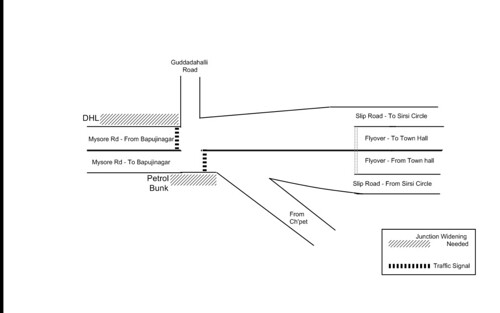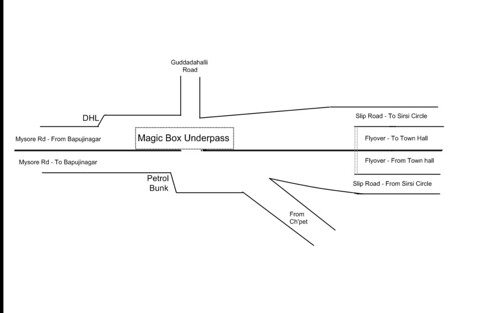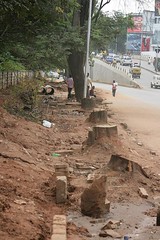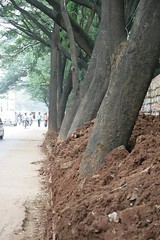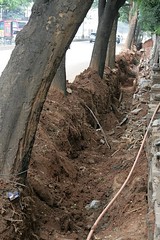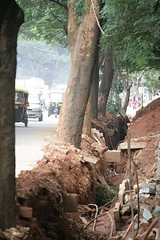BBMP and Road Widening
Most aware citizens say that widening roads to fight traffic congestion is like buying larger clothes to fight obesity. BBMP and some others feel that some arterial roads are choked, and road widening is a must.
Such direct focus on roads, and so little on mobility has been a problem with Bangalore's planners for a decade now. But its only in early 2010, when a large road widening scheme from BBMP threatened to touch thousands of private properties that the debate has hit common citizens of Bengaluru.
Scientifically speaking, city roads needs consistent width - 4 lanes would do just fine - in corridors, better management of stopping and parking along the ribbons of corridors, width for pedestrians to keep them off the tar, and improvement at junctions to manage the flow.
At times, road widening is also discussed in the context of "Signal Free Corridors". But going by BBMP's plans, it is not clear if all road widening work has been planned as part of select few "signal free corridors". Even there, feasibility of creating a dozen signal free corridors inside the city area is itself a heavily debated subject.
How Wide is Wide?

Nomatter however the road is wide, there is always traffic jams. Still BBMP seems to have not analyzed the problem and expanding the roads by cutting trees and reducing pavements has become its endless project. Today morning I saw trees on the Maharani's College Road while getting down the Anand Rao circle which were 'alive' from 100s of years being cut to widen further. Already the road is 1 way and it is a 4 lane road. Why to loose our greenery unnecessarily. Also the pavements were narrowed still further. We all know, how matter the road is wide, still traffic will not reduce. Length of the jam decreases and width increases. We have seen the examples of Bangkok, as well as we have seen the roads of California. Its all so wide still there are lots of delays in traffic. Why to loose our precious trees which are seniors in terms of age for a foolish act of road widening which we all know is not going to give us any solution. Loosing the tree for a Metro Rail / Mono Rail is OK since it is minimal as well as it is definitely give us a solution. Still, alternative routes should be taken wherever possible to avoid tree cutting such as the case in Nanda Road. I think the act of BBMP to cut trees to widen road is just 'ridiculous'. What is our environmental agency 'Hasiru Usiru' doing?
Maharajah's 13 acre donation to Bangalore


I guess the Grand Poobah has consented to giving some of his palace land for greater good so we can now get back to solving the making-cauvery-junction-signal-free riddle from square one. Hope they will build a regular flyover now and close the current magic box for good.
So the chicken neck on Bellary Road is expected to be gone in 3 months. I am confident BBMP's road engineering techniques will ensure we will have the same jams we are having now as it will just be a sea of asphalt with no pedestrian sidewalk and road markings.
Mayor shelves road widening

Just happened to come across this news from couple of weeks ago. BBMP Mayor finally shelves the road widening plans. Temporarily? Your guess is as good as mine.
Addressing a press conference Mr Nataraj said BBMP and property owners themselves were free to erase the red markings on buildings and houses in the core areas of the city for the time being. “Roads will be widened only in the newly added areas and where people themselves feel it is neccessary,” he said.
....... the mayor said he had written to the state government to earmark 20 per cent of BDA sites for a rehabilitation package for those who stood to lose 90 % of their property.
“If the government fails to respond positively road widening will be aborted,” he promised
So, does this mean they will proceed if government agrees to earmark BDA sites? What a contradiction. Our leaders have become the masters of saying both yes and no in the same breath, and we have become the masters of beliving what they say.
He also revealed that a scientific survey would be conducted from September onwards to zero in on the roads Whether we believe or not, we should at least put pressure on them to follow their words.
that need to be widened. After the survey, members of Resident Welfare Associations (RWA) and others would be consulted before the work began.
“Only If 90 % of the people agree on widening a particular stretch, will it be taken up,” Mr Nataraj added.
Mysore Road - Choke Point 1 - Guddadahalli Junction


The BBMP has propsed that the stretch from Sirsi Circle to Gali Anjaneya Temple on Mysore Road be widened. This involves chopping trees all along the stretch. These are already well-known plans from the news reports and praja discussions. There are a couple of estimates on the number of trees to be chopped some saying 50 and some 100+. But, lets not be get into the numbers. Whats important is to find ways to solve the bottleneck without chopping the trees, if any available.
Mysore Road starts from KR Market. Vehicles zip across from Town hall on the flyover for about 2.5 kms, pass over the Sirsi Circle, and get struck at the ramp of the flyover. Why ? There is a choke point immediately after the flyover (about 150mts away).
The picture above shows the road plan to the west of Sirsi Circle. The Flyover bring in two lanes of traffic, the surface level slip road from Sirsi Circle brings another two lanes of traffic and there is two more lanes of traffic joining the 'intersection' from Chamarajapet, through the Albert Victor Road. That is six lanes of traffic merging into two lanes in space of about 100 mts. Add to this, there is a right turn into Old Guddadahalli immediately after, and hence the merged traffic should also re-align lanes so enable vehicles from AV Road to enter Guddadahalli Road.
There is a traffic signal installed about 200 mts from the end of flyover, only to enable the right turn into Guddadahalli. This means the traffic on the other side of the road - from Bapujinagar to Sirsi Circle/Flyover - gets stalled at the si. gnal. This creates long jams on both sides of the road. Peaks hours are terribly bad, Saturdays are worse!!
The solution to this issue lies in widening the junction to accomodate more vehicles. Long stretches of roads need not be widened for smoother traffic flow. Its time now for BBMP to widen junctions, as against road widening. This post has a plan to fasten the exit from this intersection.
Firstly, there are two small streches to be widened (marked in the picture above). On the northern side, the strech from DHL office to the burial ground - about 200mts - has to be widened. On the other side of Mysore Road, the stretch from the end of Albert Victor road to the IOC petrol bunk (immediately after the present signal) has to be widened. This will mean loss of only 3 trees each on either side( two more have already been chopped off!!).
Another important change required at the junction is to remove the traffic signal. This can be achieved by a simple 7mts (two lane) magic box on the northern half of the Guddahalli-Mysore road junction. Illustration below.
This will assure uninterruped movement on the nothern side of the road - for vehicles from Bapujinagar side to Sirsi Circle. Post widening, there will be enough width (single lane)on the surface level for any vehicles from Bapujinagar to turn left into Guddadahalli.
For vehicles from Ch'pet or Sirsi Circle, removal of the signal will mean uninterrupted right turn into Guddadahalli. U-turns for the same vehicles will also become more faster, since they do not have to compete for the road space with the vehicles in other direction.
These two simple steps will help ensure fast movement of traffic, at only about 10% of the 17-crore budgeted for widening the road.
There are two further choke points - one near the Shell petrol bunk and another close to the Gali Anjaneya Temple. I will write on these two separately.
Road Widening Hits Road Block - PIL

Karnataka High Court admits PIL against Road Widening Projects in Bangalore
Issues emergent notices to Respondents
Mr. Chief Justice Cyriac Joseph and Mr. Justice A. N. Venugopal Gowda, constituting the Division Bench of the Hon'ble High Court of Karnataka, today admitted a Public Interest Litigation (PIL) filed by Environment Support Group and others against the ongoing irrational road widening projects of the Bruhat Bangalore Mahanagara Palike (BBMP – Corporation of the City of Greater Bangalore). Appreciating the urgency for considering the need to protect avenue trees from needless felling and safeguarding various rights and priveleges of pedestrians, street vendors, etc., the Hon'ble Judges issued emergent notices to the Respondents while also allowing for serving of hand summons.
The PIL challenges BBMP's ongoing project of widening 91 roads (a number likely to increase) in Bangalore, running into a length of about 400 kms. across the length and breadth of the old city areas. This mega project is predicated on the premise that it would result in improved flow of traffic and reduce congestion. However, no evidence has been presented to prove that the result of widening would actually achieve these objectives. In contrast to the approach adopted by BBMP, experience from densely populated and leading cities from across the world prove that widening of roads is not the solution for easing traffic congestion. Instead intelligent design approaches, responsive (rather than reactionary) traffic management, enhancement of public transport, improvement in pedestrian zones, protection of livelihoods of vendors, and discouraging personalised modes of transport have successfully addressed the most serious traffic congestion problems of mega cities. Such approaches have also enabled the protection of cultural heritage, public spaces and urban greenery, significantly enhancing the environmental quality of urban areas.
The PIL makes a strong case against tree felling as the first step to road widening by demonstrating that the work undertaken by BBMP in several roads has proved unsuccessful in reducing traffic congestion. The Petitioners submit that the actions of the Tree Officer in authorising the felling of hundreds of avenue trees violate various provisions of the Karnataka Preservation of Trees Act, and is admittedly an action taken under duress. In most cases where hundreds of really old avenue trees have been felled, the stated object of widening has not been achieved even after years, as various utilities have not shifted out of the proposed right of way, or such spaces have been encroached by places of worship.
The PIL relies heavily on the National Policy on Urban Street Vendors, the National Urban Transport Policy and a variety of circulars issued by the Union Urban Development Secretary that argue for a rational and intelligent approach to managing congestion in urban areas. In particular, it makes a case that the object of all travel is to ensure people move across cities in safety and comfort, thus necessitating privileges to pedestrian movement, non-motorised forms of transport and public transport. Contrarily, the BBMP's approach seems to arrogate a right for the private motor car over all other modes of travel, thereby extinguishing many fundamental rights, while also exposing the public at large to great discomfort and even harm.
The PIL presents a variety of evidence to argue that the road widening programme is illegal as it has skirted fundamental public consultation processes required per the Karnataka Town and Country Planning Act. In addition the draft Comprehensive Development Plan -2005 (CDP) of Bangalore Development Authority, defining land use of the city, did not contain any proposal for widening roads on such a grand scale. Surprisingly, the final CDP – 2007 introduced plans for most inner city roads to be widened without in any manner informing or involving the public, an action that is patently illegal.
The PIL is a result of a long and deliberate series of proactive steps taken by the Petitioners along with Hasiru Usiru, a network of concerned groups and individuals in Bangalore. The Petitioners draw attention to the ruling of the Hon'ble High Court of Karnataka in 2005 (WP No. 14104/2005) in which the Government was directed to involve the public in decisions relating to road widening and tree felling. It is submitted that despite exhaustive efforts on the part of the Petitioners and Hasiru Usiru urging the Government and its agencies to engage with the public in evolving such schemes, the current road widening project has been rushed through disregarding the directions of the Hon'ble Court. In this context, it is prayed that the Hon'ble Court be pleased to strike down the road widening proposals, and the consequent tree felling orders. In addition, it is prayed that the Govenment be directed to evolve rational road development proposals that met with the highest standards of law, policy and urban planning.
The petitioners Environment Support Group and CIVIC Bangalore were represented by Advocate Mr. Sunil Dutt Yadav and Mr. Leo F. Saldanha, Coordinator, Environment Support Group, appeared in person. A copy of the PIL is accessible online on ESG website.
Road Widening hits a road block?

Today’s Sunday times had the head line on road widening ahead of Food Ball news for a change.
Your house cannot be taken forcibly under TDR.
“As per the rules, BBMP can take up road widening only under the Transferable Developments Rights Scheme (TDR). If the private property owner does not cooperate in giving away his land for road widening the process cannot be taken up legally”
The only option for BBMP is to forcibly acquire the property by paying current market rate under Karnataka land acquisition act. What then was the relevance of BBMP TDR in the first place? Was it to take away the property without proper compensation?
Road Widening in Bangalore - City convention on 4th July


Hi All,
"Save Bangalore committe" has taken up for a city convention about road widening in Bangalore.
Thought of sharing the information with all of you. Please go through the attachment for the details.
Thanks,
Manoj
Hi All,
"Save Bangalore committe" has taken up for a city convention about road widening in Bangalore.
Thought of sharing the information with all of you. Please go through the attachment for the details.
Thanks,
Manoj
| Attachment | Size |
|---|---|
| road widening BSS.pdf | 335.41 KB |
Road widening - Futility & Alternatives


Road widening - Futility & Alternatives
Background
BBMP listed 217 roads to be widened. This has caused much worry among citizens as it entails widespread destruction of both greenery & property. Why do so many roads need to be widened? What are the characteristics of congestion on this road? What are the traffic patterns on these roads? Should congestion be reduced by widening or by any other strategy? Are already widened roads being used efficiently? Have we addressed the efficiency of current road widths? This paper attempts to focus on the efficiency of current available road space and put widening into perspective as a long term strategy.
Futility
The simple truth is that building more highways and widening existing roads, almost always motivated by concern over traffic, does nothing to reduce traffic. In the long run, in fact, it increases traffic.
A recent University of California at Berkeley study covering thirty California counties between 1973 and 1990 found that, for every 10 percent increase in roadway capacity, traffic increased 9 percent within four years' time1.
Yet another study, on why building wider roads isn’t the answer, in analyzing sixty road closures worldwide, found that 20 percent to 60 percent of driving trips disappeared rather than materializing elsewhere2.
USA Today published the following report on Atlanta: "For years, Atlanta tried to ward off traffic problems by building more miles of highways per capita than any other urban area except Kansas City…As a result of the area's sprawl, Atlantans now drive an average of 35 miles a day, more than residents of any other city."· This phenomenon, which is now well known to those members of the transportation industry who wish to acknowledge it, has come to be called induced traffic.
The phenomenon of induced traffic works in reverse as well. When New York's West Side Highway collapsed in 1973, an NYDOT study showed that 93 percent of the car trips lost did not reappear elsewhere; people simply stopped driving.
This condition is best explained by what specialists call latent demand. Since the real constraint on driving is traffic, not cost, people are always ready to make more trips when the traffic goes away. The number of latent trips is huge--perhaps 30 percent of existing traffic. Because of latent demand, adding lanes is futile, since drivers are already poised to use them up.
Automobile use is the intelligent choice for most people because it is what economists refer to as a "free good": the consumer pays only a fraction of its true cost. We learn in first-year economics what happens when products or services become "free" goods. The market functions chaotically; demand goes through the roof. In most cities, parking spaces, roads and freeways are free goods. Local government services to the motorist and to the trucking industry--traffic engineering, traffic control, traffic lights, police and fire protection, street repair and maintenance--are all free goods.3
A piece of statistic from the Mumbai Traffic Police web site illustrates the magnitude of the problem: While length of roads in Mumbai increased two times between 1951 and 2007, the population increased 5.4 times and the number of vehicles a whopping 43 times.
Another way of widening or adding lanes is to build elevated roads. Essentially it is another way to add bandwidth which is similarly destructive. In fact most countries are today opting to pull down the elevated highways they have built, following are some examples
|
Elevated roads already removed |
Elevated roads being removed |
Removals proposed by citizens |
|
Portland, OR: Harbor Drive |
Rochester, NY, Innerloop |
Baltimore, MD, Jones Falls Expressway |
|
San Francisco, CA: Embarcadero Freeway |
Trenton, NJ, Route 29 |
Seattle, WA, Alaska Way Viaduct |
|
San Francisco, CA: Central Freeway |
Akron, OH, Innerbelt |
Bronx, NY, Sheridan Expressway |
|
Milwaukee, WI: Park East Freeway |
Washington, DC, Whitehurst Freeway |
Buffalo, NY, Route 5 |
|
Toronto, Ontario: Gardiner Expressway |
Cleveland, OH, Shoreway |
Hartford, CT, Aetna Viaduct |
|
New York, NY: West Side Highway |
New Orleans, LA, Claiborne Expressway |
Louisville, KY, Interstate 64 |
|
Niagara Falls, NY: Robert Moses Parkway |
Nashville, TN, Downtown Loop |
Portland, OR, I-5 |
|
Boston, MA: Interstate 93 (moved underground) |
New Haven, CT, Route 34 Connector |
Chicago, IL, Lakeshore Drive |
|
Paris, France: Pompidou Expressway |
Montreal, Quebec, Bonaventure Expressway |
|
|
Seoul, South Korea: Cheonggye Freeway |
Tokyo, Japan, Metropolitan Expressway |
|
|
Sydney, Australia, Cahill Expressway: (Moving to underground) |
What do we want?
The important question is not how many lanes must be built to ease congestion but how many lanes of congestion would we want? Do we favor four lanes of bumper-to-bumper traffic at rush hour, or sixteen? So what are we trying to do with these road widening projects? Are we looking to loosen the belt to accommodate the flab or do we have a plan in place to address the bulge?
There will pretty much always be a latent demand for more driving. Much of that demand is discouraged or diverted by congestion. Much of the discouragement goes away when the road is less congested.
The key is not to strive to reduce congestion. A healthy city must provide alternatives to congestion: convenient bicycling/walking/transit, compact development, pricing roads/parking, etc. And all of these healthy alternatives are much more likely, politically, when there is a lot of congestion. It is no coincidence that those cities with the worst congestion have the best transit.4
Alternatives
Many cities have set modal share targets for balanced and sustainable transport modes, particularly 30% of non-motorized (cycling and walking) and 30% of public transport. A larger plan on limiting road facilities has to take into account provisions for public transport & NMT as well. The modal share of NMT is pretty abysmal for a populated country like ours. Today no road widening includes a default NMT/PT lanes. If transport involves moving humans from place A to place B in the most sustainable way we are exactly not doing that.
In the short term a lot of wastage in built out bandwidth is seen. This leads to traffic jams in addition to volume induced congestion. The effect of this suboptimal usage of bandwidth compounds the feeling of congestion and hence making us feel it is much worse than it actually is
Using existing road width efficiently
In India specifically, today there are many causes of misuse of the current bandwidth. The 3 E’s of traffic namely Engineering, Education & Enforcement are broken. This contributes to traffic jams which take the form of abrupt slowing down of traffic just to sort themselves out on the streets hence causing backups taking a while to unclog. Lets look at the following factors which slow down traffic
Bad Engineering
Inconsistent Lanes – Most lane markings on the roads are ill defined. The lane sizes vary anywhere from 3.5 to 4 meters or more in most stretches and are not consistent all along. Effects of this are merging, severe slowdown of movement and lower than average speed resulting from encroachment into each other’s lanes & fight over road space. This is undesirable as the road engineers have lost control of the traffic & have left the road users to define the space & fend for themselves.
The lane widths need to be tighter at 3.3 meters & consistent all along. Especially the outer lanes, toward the curb, tend to hold all excess road space as a part of the lane. These extra space needs to be blocked for vehicular access by turning them into well marked space for parking or for pedestrians/NMT. The lanes are also discontinuous in most parts. All lanes need to have continuity and any break or merge needs to be properly marked with clear advanced instructions in the form of well-placed signboards
AdHoc Parking – Free parking as currently practiced in the city is a major contributor to this congestion in fact it has been observed in places like palace road that roads have been widened only to accommodate parking. If we have to make any impact in managing traffic we need to impose true cost of parking on the users. These free goods only compound the inducements already provided by widening.
Poor Quality roads – World Bank studies have confirmed that the economic losses due to insufficient pavement thickness and poor riding quality is estimated to be of the order of Rs. 30000 crores (300 billion) per annum. This is only the vehicular operation cost and does not include cost of traffic jams caused due to slowdowns & congestions It is clear that interruptions like potholes on the road slow down vehicles causes a backup & jams. Ensuring unscientific speed breakers & potholes are removed from the road
Insufficient traffic Channelizing – Traffic channelizing is the essence of traffic engineering. It is essential to tackle junctions & merges in such a way that there are no impediments to the speed of travel. The average speed of travel can be increased by keeping traffic flowing smoother at lower speed than by having a high speed corridor with many interruptions which bring down the average speed. Junction optimization with synchronized signaling & vehicle actuated traffic lights can cut down on travel time significantly on key corridors
Bad driver Education
While Engineering lays down the standard for how the traffic should flow it is entirely useless of the drivers who use them are not aware of the appropriate driving practices. It has been found that drivers in the cities are from a lower socio economic background and arrive from places outside the city which do not have a high standard of road infrastructure. It is important then that these people are trained & certified/recertified on the upgraded infrastructure separately. A written & driving test in an RTO office should be made mandatory for people who have obtained license from outside the city. Transport department officials, Police & training institutes should have their staff certified by the Engineering team for proper usage of infrastructure. The transport department needs to also ensure basic vehicle conditions like tail lights & mirrors are in use and not broken or unusable.
Bad Enforcement
Enforcement in India is characterized by low fines leading to callousness by the vehicle user. Fines need to be increased to make it a viable deterrent & respect needs to be inculcated for Pedestrians & Bicyclists. Transportation is heavily influenced by peer behavior as it is a social exercise. If people notice some people getting away with violations they are encouraged to do the same. Hence visible policing is important to set example and induce proper driving behavior.
Prioritization
Prioritizing road widening projects that are already on stream needs to be completed, their results studied before moving forward and starting other similar projects. Corridors need to have a meaning and not every road which has traffic becomes a corridor. Certain so called corridors like Sankey road already have alternate roads under widening mode. Redundant corridors should not be built as it dilutes the purpose and focus of corridors
Measurement of traffic also has to be done using PCE units rather than PCU units as the weightage for heterogeneous traffic has to be considered. Passenger Car Equivalent (PCE) is essentially the impact that a mode of transport has on traffic variables (such as headway, speed, density) compared to a single car. Typical values of PCE (or PCU) are:
- private car (including taxis or pick-up) 1
- motorcycle 0.5
- bicycle 0.2
- horse drawn vehicle 4
- bus, tractor, truck 3.5
Congestion charging
Congestion pricing or congestion charges is a system of surcharging users of a transport network in periods of peak demand to reduce traffic congestion. Traffic in central London post congestion charging went down by about 21 per cent, and traffic speeds went up by about 10%. reports from the cities that have implemented congestion pricing schemes show traffic volume reductions from 10% to 30% as well as reduced air pollution. Singapore ERP pricing has been effective in maintaining an optimal speed range of 45 to 65 km/h for expressways and 20 to 30 km/h for arterial roads.5
References
1 Carol Jouzatis. "39 Million People Work, Live Outside City Centers." USA Today, November 4, 1997: 1A-2A. As a result of its massive highway construction, the Atlanta area is "one of the nation's worst violators of Federal standards for ground-level ozone, with most of the problem caused by motor-vehicle emissions" (Kevin Sack. "Governor Proposes Remedy for Atlanta Sprawl." The New York Times, January 26, 1999: A14).
2 Jill Kruse. "Remove It and They Will Disappear: Why Building New Roads Isn't Always the Answer." Surface Transportation Policy Project Progress VII:2 (March 1998): 5, 7.
3 Stanley Hart and Alvin Spivak. The Elephant in the Bedroom: Automobile Dependence and Denial; Impacts on the Economy and Environment. Pasadena, Calif.: New Paradigm Books, 1993, 122.
4 An excerpt from Suburban Nation: The Rise of Sprawl and the Decline of the American Dream by Andres Duany, Elizabeth Plater-Zyberk, and Jeff Speck North Point Press, 2000, pp. 88-94.
5 Wikipedia
Save these trees - road widening?

BBMP/BWSSB are at it again. I am surprised at the ease with which they go about cutting the trees.
This time it is the stretch of road between BDA junction and Cavery Theater junction (New Airport Road). Some one really very creative is at work here - they are finding new innovative ways to cut down trees and this time BWSSB has chipped in to help them.
In this particular case - BWSSB dug deep trenches just next to the trees (they are laying a pipe line). With in days most of the trees tilted dangerously towards the trench. A couple of days latter all these trees were cut down - may be citing treat to life and property. Surprise surprise, a few days latter, the foot paths are decreased and work is on to increase the width of the road - all this natak for a few extra feet of road (for a road which is already wide enough). Most of these tress were atleast 50-60 years old.
Anyways this thing has not stopped yet. This "Kill Tree" operation is on in full swing. BWSSB has gone ahead and started digging along the entire stretch. It is only a matter of days before the trees on the whole stretch will either be cut off or they will fall on their own.
The next picture shows the extent to which these trees have tilted. All that is needed to complete the "Kill Tree" operation is just a few strong winds.
Notice the deep trenches and the tilting of the trees in these pictures
I am not anti-development. BWSSB i am sure had valid reasons to put the pipe line. But what surprises me is, why they choose this side of the road? The other side has relatively (alomost none) less no of trees. Yes the would have had to dig the road at one or two places - was the cost of relaying the roads more than the life of these well grown 20-30 trees. BBMP seams to have messed up their priorities - completely.
The damage is already done. But certainly everything is not lost. Can we force BWSSB to stop this digging? I am hoping with some support structure these trees can still be saved.
I tried calling Mr S Shekar - Deputy Conservator of Forest (BBMP) on 9739042158, with out any luck. There is also a tree officer in BBMP - he can be reached on 22485317. Prajagale, please spare a few minutes and each one of you call this person to force him to do an inspection of this stretch. Also spread the word :) I am hoping against hope to save these trees.
Rithesh
Prajasevaka :)

